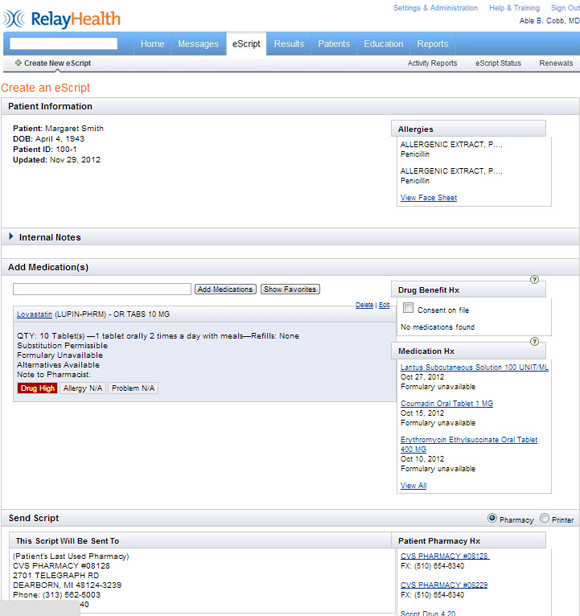E-Prescribing
RelayHealth electronic prescription helps streamline writing and refill authorization for your medical practice. Using RelayHealth, your office can instantly transmit new prescriptions and renewals to virtually any pharmacy in the US. Automatically screen for drug interactions, reduce pharmacy call-backs by checking formulary compliance prior to submission, and dramatically reduce time spent feeding fax machines.
Here is a screenshot of the e-prescribing tool in RelayHealth
RelayHealth eScript enables you to:
- Process renewal requests in one queue
- Approve renewal requests with one click
- Transmit renewal requests and authorizations electronically to virtually any pharmacy
- Reduce time phoning and faxing the pharmacy
- Improve patient safety through automatic interaction checking
- Increase patient satisfaction and outcomes by involving the patient in the process
- Minimize prescription errors
What are some of the benefits of e-prescribing?
E-prescribing gives providers an important tool to safely and efficiently manage patients’ medications. Compared to paper or fax prescriptions, e-prescribing improves medication safety, better management of medications costs, improved efficiency while improving health care quality and reducing health care costs through the reduction of adverse drug events and increased prescribing of generic medications.
Improving patient safety and quality of care.
An estimated 902 million physician office visits occurred during 2006 resulting in 3.42 billion outpatient prescriptions, yet in 2007 only 35 million of these prescriptions were sent electronically and this is more than doubled in 2008 to 78 million. There is the potential to use e-prescribing for a majority of prescriptions – including new prescriptions and renewals of ongoing prescriptions. With the increasing volume of medications and the growing complexity of patients’ medical needs, there is an increased risk of errors and adverse drug events. E-prescribing can improve patient safety and quality of care through a variety of mechanisms including eliminating illegible prescriptions, reducing oral miscommunications, the implementation of warning and alert systems at the point of prescribing, and giving the provider access to the patient’s complete medication history.
Reduce time on phone calls to and from pharmacies.
A 1999 study conducted for the National Association of Chain Drug Stores estimated that pharmacy staff made more than 150 million calls to physician practices annually to clarify prescriptions or discuss possible errors. This means that physicians and their staff spend hours every day responding to these requests. The implementation of an e-prescribing system can potentially reduce the time spent on pharmacy callbacks, faxing prescriptions to pharmacies, and automating the prescription renewal request and authorization process. This can reduce the cost of prescribing for both physicians and pharmacies, by saving time and resources and increasing patient convenience.
Increase patient convenience and medication compliance.
Studies have found that patients may not fill new prescriptions and/or substitute an over-the-counter (OTC) medication in place of a prescription. Making the process of prescription filling easier for patients is likely to improve patient compliance with their medications. E-prescribing can help decrease the number of unfilled prescriptions by removing one step in the traditional prescription filling process (that of delivering the prescription and waiting for it to be filled), but additionally e-prescribing builds a more complete medication history from all the pharmacies and physicians a patient may use. This can be transmitted back to prescribers to help them evaluate and focus on issues of patient compliance.
Improved formulary adherence permits lower cost drug substitutions.
E-prescribing can also direct cost savings for both the patient and insurers. Many pharmacy benefit managers (PBMs) and insurers provide detailed information concerning their formularies and the benefits structure of the patient’s plan. By providing this information to providers at the point of care, it allows identification of what medications are on the formulary and encourages an increased use of generic medications or lower cost therapeutically equivalent medications.







